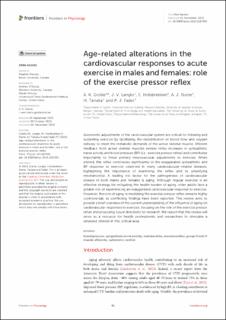| dc.contributor.author | Grotle, Ann-Katrin | |
| dc.contributor.author | Langlo, Jonas Vindedal | |
| dc.contributor.author | Holsbrekken, Eivind | |
| dc.contributor.author | Tanaka, Hirofumi | |
| dc.contributor.author | Stone, Audrey J. | |
| dc.contributor.author | Fadel, Paul J. | |
| dc.date.accessioned | 2024-02-02T12:34:52Z | |
| dc.date.available | 2024-02-02T12:34:52Z | |
| dc.date.created | 2024-01-28T13:03:15Z | |
| dc.date.issued | 2023 | |
| dc.identifier.issn | 1664-042X | |
| dc.identifier.uri | https://hdl.handle.net/11250/3115293 | |
| dc.description.abstract | Autonomic adjustments of the cardiovascular system are critical for initiating and sustaining exercise by facilitating the redistribution of blood flow and oxygen delivery to meet the metabolic demands of the active skeletal muscle. Afferent feedback from active skeletal muscles evokes reflex increases in sympathetic nerve activity and blood pressure (BP) (i.e., exercise pressor reflex) and contributes importantly to these primary neurovascular adjustments to exercise. When altered, this reflex contributes significantly to the exaggerated sympathetic and BP response to exercise observed in many cardiovascular-related diseases, highlighting the importance of examining the reflex and its underlying mechanism(s). A leading risk factor for the pathogenesis of cardiovascular disease in both males and females is aging. Although regular exercise is an effective strategy for mitigating the health burden of aging, older adults face a greater risk of experiencing an exaggerated cardiovascular response to exercise. However, the role of aging in mediating the exercise pressor reflex remains highly controversial, as conflicting findings have been reported. This review aims to provide a brief overview of the current understanding of the influence of aging on cardiovascular responses to exercise, focusing on the role of the exercise pressor reflex and proposing future directions for research. We reason that this review will serve as a resource for health professionals and researchers to stimulate a renewed interest in this critical area. | en_US |
| dc.language.iso | eng | en_US |
| dc.publisher | Frontiers | en_US |
| dc.rights | Navngivelse 4.0 Internasjonal | * |
| dc.rights.uri | http://creativecommons.org/licenses/by/4.0/deed.no | * |
| dc.subject | Treningsfysiologi | en_US |
| dc.subject | Exercise physiology | en_US |
| dc.subject | Sirkulasjonskontroll | en_US |
| dc.subject | Blood flow control | en_US |
| dc.subject | Blodtrykks regulering under trening | en_US |
| dc.subject | Blood pressure regulation during exercise | en_US |
| dc.subject | Aldring | en_US |
| dc.subject | Aging | en_US |
| dc.subject | Hjerte-karfysiologi / kardiovaskulærfysiologi | en_US |
| dc.subject | Cardiovascular Physiology | en_US |
| dc.subject | Fysisk aktivitet | en_US |
| dc.subject | Physical activity | en_US |
| dc.subject | Trening | en_US |
| dc.subject | Exercise | en_US |
| dc.title | Age-related alterations in the cardiovascular responses to acute exercise in males and females: role of the exercise pressor reflex. | en_US |
| dc.type | Peer reviewed | en_US |
| dc.type | Journal article | en_US |
| dc.description.version | publishedVersion | en_US |
| dc.rights.holder | © 2023 Grotle, Langlo, Holsbrekken, Stone, Tanaka and Fadel | en_US |
| dc.source.volume | 14 | en_US |
| dc.source.journal | Frontiers in Physiology | en_US |
| dc.identifier.doi | 10.3389/fphys.2023.1287392 | |
| dc.identifier.cristin | 2236123 | |
| dc.source.articlenumber | 1287392 | en_US |
| cristin.ispublished | true | |
| cristin.fulltext | original | |
| cristin.qualitycode | 1 | |

